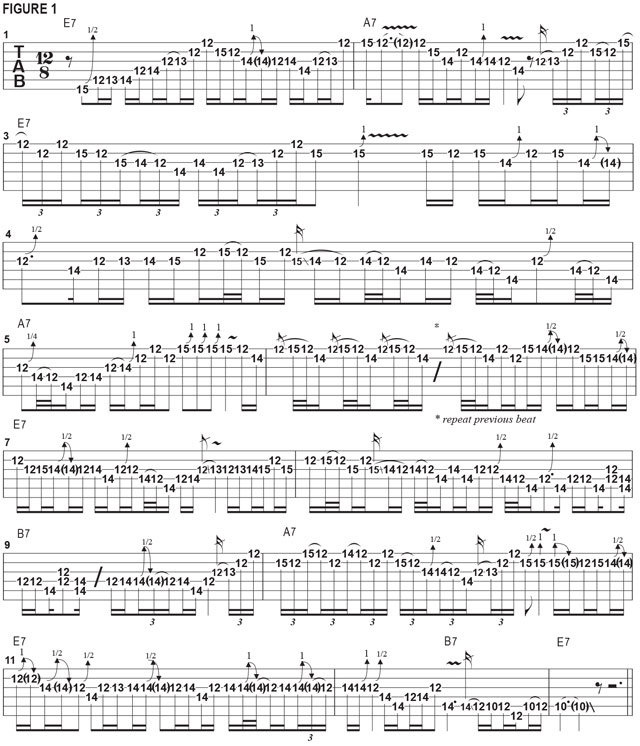Getting the Most Out of One Fretboard Position

In this fourth installment of our study of slow blues soloing, we’ll again focus on utilizing a single fretboard position of the blues scale while additionally including the major third of the tonic, or “home” chord.
The example in this column (see FIGURE 1) is played over a slow 12-bar blues progression in E, so we’re going to use the E blues scale (E G A Bb B D) with the inclusion of the major third, G#. This results in a hybrid scale, spelled E G G# A Bb B D, or, intervallically, 1 b3 3 4 b5 5 b7.
The most useful thing about this hybrid scale is that the inclusion of the major third serves two purposes: it functions as a chord tone of E7, thus solidifying the connection between the improvised melodies and the underlying tonic, while also establishing a chromatic row from the minor, or “flatted,” third, G, up to the fifth, B.
As we have done with all of the examples in the previous three lessons, the major third, G#, will always follow the minor third, G, sequentially, whether the melodic line is ascending or descending. This way, the major third serves as a targeted, or highlighted, note within the melody. The area of focus for this month’s original solo is 12th position. In this solo, the major third, G#, is added to the E blues scale in two places.
The first is as the third note in the scale when ascending from the E note on the sixth string’s 12th fret, sounded by bending G, 15th fret, up a half step to G#. We also include a G# note one octave higher, on the third string’s 13th fret. Keep in mind that you could additionally play the major third, G, another octave higher while remaining in 12th position, by bending the G note on the high E string’s 15th fret up a half step to G#, just as we had done on the low E string.
The majority of the solo is played in a rhythm of 16th notes. In 12/8 meter, three evenly spaced eighth notes fall within each of the four primary beats of the bar, resulting in a feel that may be counted “ONE two three, FOUR five six, SEV eight nine, TEN ’lev twelve.”
When playing 16th notes over this feel, they’re evenly spaced across each eighth note, resulting in a rhythm that may be counted “ONE-an two-an three-an, FOUR-an five-an six-an, SEV-an eight-an nine-an, TEN-an ’lev-an twelve-an.”
You’ll also encounter a few 16th-note triplets and pairs of 32nd notes in the solo. In 12/8, 16th-note triplets may be counted “ONE trip-let two trip-let three trip-let, FOUR trip-let five trip-let six trip-let, SEV trip-let eight trip-let nine trip-let, TEN trip-let ’lev trip-let twelve-trip-let.” Be sure to count through each phrase slowly and carefully as you play, in order to accurately recreate the melodic rhythms.

Get The Pick Newsletter
All the latest guitar news, interviews, lessons, reviews, deals and more, direct to your inbox!
Guitar World Associate Editor Andy Aledort is recognized worldwide for his vast contributions to guitar instruction, via his many best-selling instructional DVDs, transcription books and online lessons. Andy is a regular contributor to Guitar World and Truefire, and has toured with Dickey Betts of the Allman Brothers, as well as participating in several Jimi Hendrix Tribute Tours.
“There are so many sounds to be discovered when you get away from using a pick”: Jared James Nichols shows you how to add “snap, crackle and pop” to your playing with banjo rolls and string snaps
Don't let chord inversions bamboozle you. It's simply the case of shuffling the notes around








![Joe Bonamassa [left] wears a deep blue suit and polka-dotted shirt and plays his green refin Strat; the late Irish blues legend Rory Gallagher [right] screams and inflicts some punishment on his heavily worn number one Stratocaster.](https://cdn.mos.cms.futurecdn.net/cw28h7UBcTVfTLs7p7eiLe.jpg)


